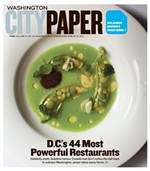Cheeky Monkey
When an ape loves a woman, it turns out that he likes to woo the object of his affection the same way upright-walkin’ dudes do—the more sensitive ones, anyway. The beast will cuddle up to his sweetie and peacefully enjoy the sunset. Or gaze into her eyes in the middle of a quiet, snow-dusted street. And when the animal gets confused and frustrated while gallantly trying to walk on ice with her in his arms, he will just fall down and start gliding in circles with his girl, both giggling—yes, giggling—the whole time.
At least that’s how it goes in the Hobbit King’s mind. And goes and goes—for 187 minutes, nearly double the length of the 1933 original. How did Peter Jackson and co-writers Fran Walsh and Philippa Boyens stretch Merian C. Cooper and Edgar Wallace’s relatively simple story to such epic proportions? Well, the movie is first a smaller-scale Titanic, then a ballsier Jurassic Park—and that’s before the monkey business even gets going. Anybody whining about the quickly spread fact that it takes more than an hour for the breathtaking Kong to appear should be grateful for the leisurely introduction—because once the astounding action starts, it doesn’t let up for a long, long time.
The story still begins in 1933 New York, where the Depression has put vaudeville performer Ann Darrow (Naomi Watts) out of work. As she’s contemplating a career change outside a burlesque house, a nutty, opportunistic, Orson Welles–esque film director, Carl Denham (a perfectly cartoonish Jack Black), decides that Ann is the right woman to replace the actress who ditched him for an upcoming overseas shoot. (Requirements: pretty face, size 4. “Fay’s a size 4!” Carl blurts, one of Kong’s many winks to the original.) Soon enough, they’re off on a rickety ship to Carl-Knows-Where—and quickly, to avoid the producers who want Carl’s head for wasting their money on an earlier movie. The cranky captain (Thomas Kretschmann) eventually tires of Carl’s vague directives and decides to take the ship home in the dark and fog. But before he can, a crew member cries, “Wall! There’s a wall ahead!” and Phase I of the mayhem begins. Only Celine Dion is missing from Jackson’s depiction of angry waves, tossing about, and general chaos.
It’s difficult to discuss what awaits the crew on Skull Island without sounding like a drooling fangirl. The island: a magnificent ruin, its high walls embedded with skeletons. The natives: mobs of The Serpent and the Rainbow zombies, eyes red or rolled right back in their heads, with stringy hair and a taste for human flesh. The sequence in which they attack Carl & Co. during a rainstorm and chase them back to the battered boat is its own little horror movie, and it’s only a hint of what the survivors will face after the fair Ann is offered to Kong.
Jackson has claimed that the 1933 Kong was his favorite movie as a kid and that faithfulness to it was his paramount concern—he even obtained models and storyboards from the original, the latter of which were used to re-create the legendary lost giant-spider sequence. But with more than 70 years’ worth of new technology at his disposal, he inevitably made something bigger, scarier, and more spectacular in every way. Kong, unlike his goofy-faced predecessor, is a terrifically realistic being, with discernible expressions (provided by Jackson’s Gollum, Andy Serkis) and a roar that will rattle your seat. But even more frightening are the island’s dinosaurs, whose attacks on the crew are incessant and heart-pounding. Throughout, Lord of the Rings cinematographer Andrew Lesnie alternates between foggy pall and vivid jungle, the latter lit by brilliant orange-pink skies.
Given all the aces CGI, it’s surprising that there are a few green-screen scenes that look terribly cheesy, especially when an actor is running parallel to a digital monster. Another quibble is the slo-mo Jackson sometimes uses to needlessly emphasize the drama. Even if the gesture is intended to slyly remind us that we’re watching a reportedly $207 million B-movie, it’s annoying. And following a middle chapter of relentless action, the gooey love stuff that occurs after Kong busts out on Broadway sure takes steam out of this juggernaut—really, when a film’s closing in on its third hour, the audience could probably do without the Beauty/Beast romantic turn around an ice rink.
It might be letting Jackson off a little easy to say that he’s merely tweaking cinematic convention. But the story’s tragic end is supposed to be boo-hooey sap, which the filmmakers emphasize by giving Ann a nasty case of Stockholm syndrome and having her reciprocate Kong’s love. But call me fangirl. Besides, the film’s gushy mood shift—which, come to think of it, also ends in a very Titanic way—is small penance for all the stunning stuff that comes before. Jackson clearly made his King Kong with geeked-out love and childlike wonder, and the result is by far the best action movie of the year.

